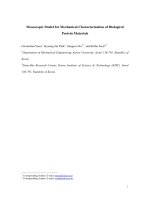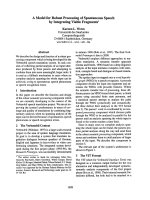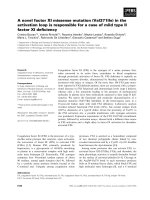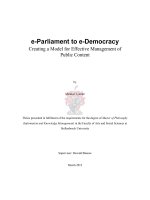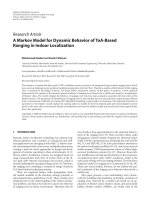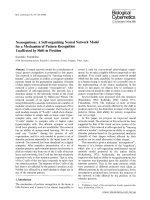Revisiting the Fama and French three-factor model for the case of Vietnam
Bạn đang xem bản rút gọn của tài liệu. Xem và tải ngay bản đầy đủ của tài liệu tại đây (14.55 MB, 6 trang )
Researches & discussions
This paper is to investigate the fitness of the Fama and French three-factor model in
the HCMC Stock Exchange (HOSE) over the period 2007-2009. The results have proven
that this model is more superior to the capital asset pricing model (CAPM) when explaining changes in the total risk premium or the return on equity in HOSE; yet it is not to
veto that CAPM is not an effective tool to analyze the total risk premium or the return on
equity, which is not only affected objectively by the market forces but also subjectively by
features of listed companies such as their size and value (the book-to-market ratio
[BE/ME]). The results also figure out that the market factor out of three factors produces
the biggest effect on the total risk premium of a stock. In other words, although investors
in HOSE have attended to features of listed companies, it is kind of humble. Their investing decisions are mainly based on ups and downs of the market.
Keywords: Fama and French three-factor model, Vietnam
1. Literature review
Theories on capital market have facilitated the
development of the portfolio theory introduced by
harry Markovitz in 1952, and risk-weighted asset
pricing models. in the early time, William sharpe
did propose his capital asset Pricing Model
(caPM) which was first published on the Journal
of Finance in 1964. caPM allows us to define the
essential return on a risk-weighted asset by
adding the market risk premium of such the asset
to the risk-free interest rate of treasury bills.
however, caPM, when tested in different markets at different periods, did not always produce
expected results. Thus, numerous studies have
been conducted then and many observed variables
have been added to the pricing model. We can ex-
* University of Economics - HCMC
** Nestle Ltd. Co.
emplify the study of eugene F. Fama and Kenneth
r. French in 1992.
Fama and French have tried to evaluate the
role of market’s beta, size, P/e ratio, financial
leverage, and Be/Me within the average return of
different sectors on stocks of nYse, aMeX and
nasDaQ. Previous studies did find out the positive relationship between return and beta. The
study by Fama and French has pointed out the relationship between beta and the average return
which did vanish during the period 1963 – 1990
even in times when only beta is employed to explain the average return. Vice versa, sole tests
have found that the average return has significant
rapports with firm size, financial leverage, P/e
ratio and Be/Me. This study is to investigate the
Economic Development Review - January 2011
43
Researches & discussions
Fama and French three-factor model in hose.
2. Fama and French three-factor model
Fama and French recognize that the beta factor of caPM developed by William sharpe could
not explain changes in the average return on securities in the us market during the period 1963
– 1990. Thus, they started to observe the average
return on stocks listed in nYse, aMeX and nasDaQ; and realized two classes of stock whose average return tended to be better than that of the
whole market, including small caps and high
book-to-market ratio. accordingly, they developed
the model of three factors, viz. market’s risk premium, book equity, and company size. of them,
the book-to-market ratio represents the company’s
value; and the market capitalization stands for the
company’s size. in other words, small caps will
have small size; big caps have big size; stocks with
high book-to-market ratio are called value stocks;
stocks with low book-to market ratio are called
growth stocks. in this model, small-cap stocks own
an expected risk premium higher than that of big
caps; and value stocks have an expected risk premium higher than that of growth stocks. The
Fama-French model can explain over 90% (r2
0.9) of the diversified portfolios returns in the us
market (nYse, aMeX and nasDaQ) compared
to the 70% (r2 = 0.7) produced by caPM.
The value premium represents the difference
between the average portfolio return on value
stocks and that on growth stocks. similarly, the
size premium represents the difference between
the average portfolio return on small-cap stocks
and that on big-cap stocks. Factors developed
within the Fama-French model can be explained
as follows:
Market premium is the premium for investorburdened risks related to market factors.
l
l size premium is the premium for impacts of
company size
Value premium is the premium for impacts
of company’s value
l
The formula of the Fama-French model can be
written as follows:
Rit - R ft = a + b 6 Rmt - R ft @ + sSMBt + hHMLt + ft
44
Economic Development Review - January 2011
Where,
Rit - R ft : Total risk premium at the time t
a : ordinate origin of the regression equation
b(rmt - rft) : Market premium at the time t
ssMBt : size premium at the time t
hhMLt : Value premium at the time t
et : random error at the time t
Rit : expected average return on stocks at the
time t
rmt : Market return at the time t
rft : risk-free interest rate (treasury bill rate)
at the time t
b, s, h: Partial regression coefficients
sMBt (small minus big): the difference between
the average return of small-cap stocks and that of
big-cap stocks at the time t
hMLt (high book-to-market minus low book-tomarket): the difference between the average return of stocks with high book-to-market ratio
(value stocks) and that of stocks with low book-tomarket ratio (growth stocks) at the time t
3. Previous results from testing the FamaFrench model
The Fama-French model has been tested in
many different markets and produced the following results.
* all regression coefficients of portfolios allocated by Bundoo to the Fama-French model have
the significance of 99%. Thus, Bundoo did not run
the mono-variable regression model.
such studies conducted in the us, France, new
Zealand, australia, south africa, india, hong
Kong, Korea, Malaysia and Philippines rendered
that the average return on portfolios of small caps
is higher than that of big caps; and that the relationship between the company’s size and the return on equity is inverse. These studies also
showed that the return on stocks with high bookto-market ratio is higher than the return on those
with low book-to-market ratio; in other words, the
return of growth stocks is lower than that of value
stocks; and that the relationship between the return on equity and the book-to-market ratio is positive. however, the study by Bhavna Bahl (2006)
for the emerging market of india produced the in-
Researches & discussions
Table 1: Results from testing the Fama-French model and CAPM in Vietnam and other markets in the world
Stock exchanges
Researchers and years of
publication
R2 of
Fama-French model
R2 of CAPM
NYSE, AMEX & NASDAQ
(1963-2003)
Nima Billou (2004)
0.72
0.89
France (1976-2001)
Souad Ajili (2005)
0.714
0.905
New Zealand (1994-2002)
Nartea & Djajadikerta (2005)
0.36
0.441
Australia (1981-2005)
Michael A. O'Brien (2007)
0.439
0.73
South Africa (1998-2004)
Sunil K Bundoo (2006)
*
0.71
India (2001-2006)
Bhavna Bahl (2006)
Hong Kong (1993-1999)
Korea (1991-1999)
Malaysia (1991-1999)
Drew & Veeraraghavan (2003)
Philippines (1994-1999)
HOSE (Jan.2005-Mar.2008)
Vương Đức Hoàng Quân & Hồ
Thò Huệ (2008)
verse, viz. the return would soar up when the
book-to-market ratio increases from low to
medium; and go down when from medium to high.
in Vietnam, the study by Vương Đức hoàng
Quân and hồ Thò huệ in hose in 2008 also figures out that the average return of small caps is
higher than that of big caps; and that the relationship between the company’s size and the return
on equity is inverse. This study rendered that the
return on stocks with low book-to-market ratio is
higher than the return on those with high bookto-market ratio; in other words, the return of
growth stocks is higher than that of value stocks;
and that the relationship between the return on
equity and the book-to-market ratio is inverse.
This is to state, the research results of these two
authors are contrary to findings from both developed and emerging markets.
nonetheless, there are some points in the
study by Vương Đức hoàng Quân and hồ Thò huệ
to be reconsidered, that is, the market value of equity are calculated by the product of the quantity
of stocks issued and the market value of stocks;
the risk-free interest rate employed for the study
is that of the five-year government bond; and the
number of samples is too humble (28 companies).
The market value of equity should be calculated by
the product of the quantity of outstanding ordinary
stocks and the market value of stocks. The quan-
0.76
0.87
0.4
0.625
0.51
0.793
0.7
0.893
0.42
0.653
0.625
0.868
tity of stocks issued is different from the quantity
of available stocks if the company buys back its
outstanding stocks and keep them as reacquired
stocks. The risk-free interest rate should be taken
from treasury bills due to the fact that the fiveyear government bond may involve inflation as
their potential risk. The number of samples (28
companies) is so humble that its statistical significance is rather low.
The study by Đinh Trọng hưng in hose in
2008 also expresses itself some drawbacks, that
is, (1) the risk-free interest rate was taken from
the five-year government bond, (2) the r2 of each
stock code was produced without running the regression model equation, (3) the number of samples was too modest (just 26 companies), (4) the
duration of observation was too short (just 15
months as from sept.30, 2006 to Dec.31, 2007),
and (5) the study conducted in hose in 2008 did
produce the same regression results as those of
Vương Đức hoàng Quân and hồ Thò huệ .
4. Research design
This study is to investigate the fitness of the
Fama and French three-factor model in hose by
linear regression analyses based on ordinary least
squares (oLs) with the secondary database, which
is mainly from financial statements and prospectuses and number of outstanding ordinary stocks
retrieved
from
websites
of
hose
Economic Development Review - January 2011
45
Researches & discussions
(www.vse.org.vn) and BiDV (www.bsc.com). The
risk-free interest rate employed in the research is
that of treasury bill retrieved from the state
Bank’s website (www.sbv.gov.vn). Besides, the
Vn-index and the closing prices of stocks from
listed companies after each trading session were
retrieved from www.cophieut68.vn. This study is
just to investigate non-financial companies listed
in hose before Jan.01, 2007 with database collected from 2007 through 2009.
The study tests the following hypotheses:
l h1: There is a positive relationship between
the market risk (Market) and the total risk premium of stocks.
l h2: There is an inverse relationship between
the company’s size (size) and the total risk premium of stocks.
h3: There is a positive relationship between
the company’s value (Value) and the total risk premium of stocks.
l
The variables of the study have been explained
in the Table 2 below.
Table 2: Research variables
Variable
Symbol
Explanation
Total risk
premium
RPi
Rit - R ft : The difference between the expected average return on equity and the treasury
bill interest rate
Market
premium
RPm
Rm - Rf: The difference between the market return and
the treasury bill interest rate
Size
premium
SMB
The difference between average return on small-cap stocks
and that on big-cap stocks
HML
The difference between the average return on stocks with
high book-to-market ratio (value
stocks) and that on stocks with
low book-to-market ratio
(growth stocks)
Value
premium
The book equity is the equity value of a company as shown in its financial statement. The
market equity is the product of the market value
of a share and the quantity of outstanding stocks.
The risk-free interest rate is the daily interest
rate of treasury bill. after calculating the market
46
Economic Development Review - January 2011
equity of each companies in the study, their stocks
are classified into two different groups on the
basis of the median value of the market equity as
follows:
Group s (small-cap) includes stocks with the
market equity smaller than the median value.
l
Group B (big-cap) includes stocks with the
market equity larger than, or equal to, the median
value.
l
identically, we calculate statistical values of
the book-to-market ratio and then classify them
into three groups:
Group L (low) includes 30% of stocks with the
smallest book-to-market ratio.
l
l Group M (medium) includes 40% of stocks
with the median book-to-market ratio.
Group h (high) includes 30% of stocks with
the highest book-to-market ratio.
l
By combining these five groups together, we
will have six types of company’s size (s/L, s/M,
s/h, B/L, B/M, B/h).
on Jan.01, 2007, there were 95 publicly-held
companies and six securities companies in hose.
These companies are left out this study due to the
fact that some of them did not trade on the floor
some times and two companies did not provide
with the financial statements (the Quarter ii/2009
financial statement of iFs and the Quarter
iV/2009 financial statement of Vis). Therefore,
there are 76 suitable companies observed in the
study. Financial indicators are taken from 2007
through 2009. The securities prices have been observed in 749 trading sessions for each observed
company.
The median value is calculated on the ground
of market equities of 76 companies. By this median value, we classify stocks into two groups of s
and B; and each group will contain 38 stocks.
after having the book-to-market value, there are
23 stocks for group L, 30 ones for group M, and 23
ones for group h.
sMB explains the difference over trading sessions between the average return on small-cap
stocks (s/L, s/M, s/h) and that on big-cap stocks
(B/L, B/M, B/h). hML is the difference between
the average return on stocks with high book-to-
Researches & discussions
Table 4: Regression results
market ratio (s/h, B/h) and the return on those
with low book-to-market ratio (s/L, B/L).
Model summary
5. Testing results
collected data have been processed via three
steps: statistical descriptions, correlation analyses
and running regression model respectively. The
stat values of research variables are rendered in
Model
R
R2
R2
adjusted
Estimate standard deviation
1
.951a
0.904
0.904
0.62263
Predictors: (constant), RPm, SMB, HML
Linear regression results
Non-standardized
coefficients
Model
1
B
Standard
deviation
(Constant)
-0.026
0.023
RPm
SMB
0.922
0.011
0.39
HML
0.119
Standardized
coefficient
Collinear statistics
T
Sig.
Beta
Tolerance
VIF
-1.149
0.251
0.97
83.273
0
0.944
1.059
0.033
0.175
11.838
0
0.589
1.697
0.029
0.059
4.097
0
0.616
1.622
Dependent variable: risk premium (RPi)
the Table 3.
Table 3: The statistical descriptions of variables
(N=749)
Items
Min
Max
Mean
RPi
-4.72%
4.79%
-0.06%
RPm
-4.72%
8.04%
-0.06%
SMB
-3.91%
3.52%
0.03%
HML
-3.99%
4.12%
0.02%
regression results (Table 4) for testing the
Fama and French three-factor model have shown
that the r2 and the adjusted r2 are quite high
(0.904). This is to say, the data taken from 2007
through 2009 in hose for testing the FamaFrench model can explain 90.4% of risk premium
of average returns on stocks listed in hose. The
anoVa table also renders the sig value of regression equation is smaller than 0.05, proving that
the statistical significance of 1% of the research
model is suitable to the regression equation. Thus,
the three hypotheses are acceptable and suit the
empirical model:
Rit - R ft = -0.026 + 0.922*(rm – rf) + 0.390*sMB
6. Conclusion
The Fama and French three-factor model explains changes in the total risk premium or the
return on equity listed in hose better than
caPM; yet caPM, with the explaining level of
80%, is still an effective tool for individual investors. The total risk premium or the return on
equity listed in hose is affected not only by market factors but also by the size and value of listed
companies. of three factors affecting the risk premium of stocks, as shown in the research results,
the market is the most significant. Factors such
as size and value of listed companies explain the
return on stocks at a humble level. in other words,
the market’s upheavals are the main factor affecting the decision of investors in the period 2007 –
2009. Taking the early year 2007 into account,
when the Vn-index hit the peak of 1170 points,
investor did rush to acquire stocks without caring
about who had offered them, which industry they
belonged to, how the listed companies performed,
and etc. Besides, this study also provides investors
with an effective tool to foresee the return of
stocks in hose and make the best investmentn
+ 0.119*hML
Economic Development Review - January 2011
47
Researches & discussions
References
1. Bhavna Bahl (2006), “Testing the Fama and
French Three-Factor Model and Its Variants for the Indian Stock Returns”, Working Paper Series.
2. Drew, M.E and M. Veeraraghan (2003), “Beta,
Firm Size, Book-to-Market Equity and Stock Returns”,
8. Nima Billou (2004), “Tests of the CAPM and Fama
and French Three-Factor Model”. Working Paper.
9. Reilly Brown (2008), Investment Analysis & Portfolio
Management, 7th ed., pp.292-297
10. Souad Ajili (2005), “The Capital Asset Pricing
Journal of the Asia Pacific Economy, Vol.8, No.3, pp.354-
Model and the Three Factor Model of Fama and French
379.
Revisited in the Case of France”, Working Paper.
3. Đinh Trọng Hưng (2008), “Ứng dụng một số mô
11. Steven L. Pollock, CFP (June 2007), “Using
hình đầu tư tài chính hiện đại vào thò trường chứng khoán
three-factor theory to assess investment performance”,
Việt Nam” (Application of some modern financial invest-
Journal of Financial Planning, pp.66-75.
ment models into the Vietnam’s market), unpublished
Master Thesis of Economics.
4. Eugene F. Fama & Kenneth R. French (1996),
“Multifactor explanations of asset pricing anomalies”,
Journal of Finance, Vol.51, No.1, pp.55-82.
12. Sunil K Bundoo (2004), “An Augmented Fama
and French Three-Factor Model: New Evidence from an
Emerging Stock Market”, Working Paper.
13. Vương Đức Hoàng Quân & Hồ Thò Huệ (2008),
“Đi tìm một mô hình dự báo suất sinh lợi cổ phiếu thích
5. Eugene F. Fama & Kenneth R. French (2004),
hợp đối với thò trường chứng khoán Việt Nam” (Seeking
“The Capital Asset Pricing Model: Theory and Evidence”,
a suitable model to foresee the stock returns for the case
The Journal of Economic Perspectives, Vol.18, No.3,
pp.25-44.
6. Michael A. O’Brien (2007), “Fama and French Factors in Australia”, Working Paper Series
7. Nartea, G.V. and H. Djajadikerta (2005), “Size and
Book-to-Market Effects and the Fama-French Three-Factor Model: Evidence from New Zealand”, Proceedings of
the UM-FBA Asian Business Conference, Kuala Lumpur,
48
Malaysia, pp.510-521.
Economic Development Review - January 2011
of Vietam’s stock market).

